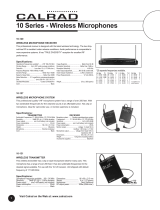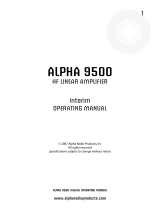Page is loading ...

1
Kenwood TS-870 HF Transceiver
International Radio Filter Installation
The International Radio filters are easily installed in the TS-870 transceiver. The #94 is
used for 8.830MHz and #96 for 455kHz IF stages. The most difficult aspect is removing
the stock filters. The ground terminal of these filters require the most attention and care
must be taken to not remove the eyelet connecting the top and bottom foil traces.
Best wishes,
Dick – AL7B
Coax Preparation
Four lengths of RG-174 type coax are used for connection of the new filters to the radio
circuit boards.
• Two coax assemblies for each filter
• Each assembly about 4.5” in length
o Remove about ¾” of the outside jacket.
o Cut the shield braid back about ½” to expose ¼” of braid.
o Small gauge wire is connected to the braid. No. 30 wire wrap wire works
well.
Strip about ¾” of the insulation from the wire.
Wrap the wire several times around the braid.
Solder the wire to the shield.
o Remove ¼” insulation from the center conductor and tin.
o Install heat shrink tubing over the coax shield.
o Cut the braid wire to length, about ¾” and remove ¼” insulation.

2
455kHz #96 Filter
The INRAD #96 filter connects to the Connection Board that is located on the radio top,
just behind the speaker.
• Remove the Connection Board.
• Remove the stock 3kHz filter – Labeled CFJ455K.
• Install a coax at each filter connection point, noting the shield connects to the
circuit board ground.
• Install the Connection Board
• Solder the coax leads to the #96 filter, noting the shield connects to the filter
ground. Either terminal set can be used for input or output.
• Install the #96 filter to the speaker bracket using Velcro type material. Access to
the PLL board below the Connection Board requires removal of the Connection
Board. Velcro type installation allows for easy access to the PLL Board.
o An alternate location is above connector CN403 on the side panel. This
location is troubled by inductors L464 and L465 and can short to ground if
contacting the bottom of the #96 filter. Again, Velcro material is used to
allow access to the PLL Board.
Bench testing of the radio showed no circuit tuning was required after installing the new
filter.

3
8.830MHz #94 Filter
The INRAD #94 filter connects to the RF Board that is located on the radio bottom.
• Remove the shield from the RF Board
• Make careful note of the connections used. This board has many test locations so
will not have cables or coax installed. The use of a digital camera would be
helpful before proceeding.
• Remove the RF Board and cables as required.
• Remove the stock 3kHz filter – Labeled YK-88S2.
• Install a coax at each filter connection point, noting the shield connects to the
circuit board ground.
• Install the RF Board.
• Install the shield on the RF Board.
• Solder the coax leads to the #94 filter, noting the shield connects to the filter
ground. Either terminal set can be used for input or output.
• Install the filter to the chassis closest to the front panel using thin double stick
tape.
Bench testing of the radio showed no circuit tuning was required after installing the new
filter.

4
RF Board With Shield Removed
/



